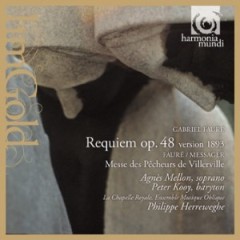Faure, Messager - Requiem, Messe des Pecheurs de Villerville (2008)
Faure, Messager - Requiem, Messe des Pecheurs de Villerville (2008)

Requiem, Op. 48 1. I. Introït 7:20 2. II. Offertoire 8:00 3. III. Sanctus 3:26 4. IV. Pie Jesu 4:23 5. V. Agnus Dei 6:38 6. VI. Libera me 4:35 7. VII. In Paradisum 4:09 Messe Des Pêcheurs de Villerville 8.I. Kyrie (Messager) 4:41 9. II. Gloria (Fauré) 4:33 10. III. Sanctus (Fauré) 2:04 11. IV. O Salutaris (Messager) 3:03 12. V. Agnus Dei (Fauré) 3:14 Agnes Mellon - soprano Peter Kooij – baritone La Chapelle Royale Les Petits Chanteurs de Saint-Louis Ensemble Musique Oblique Philippe Herreweghe - conductor
Well, this will set the cat among the pigeons, and no mistake. It has long been obvious that the 1901 published score of Faure's Requiem is a very fishy document indeed. The violin and woodwind parts and, for much of the time, those for trumpets and trombones seem expressly designed to be as inaudible as possible. They are for the most part silent and seldom do anything else but inconspicuously double lines that did not need doubling in the first place. The 1901 score is of uncertain provenance (no manuscript source for it has ever come to light) and it seems probable that Faure merely acquiesced in its preparation, urged by his publisher to make the work more saleable by at least disguising its orchestra as a standard one. The Requiem had been in existence and had been fairly frequently performed for a dozen years before 1901, and although Faure had modified the scoring over that period he had never added more than a solo violin to his basic string force of divided violas, divided cellos and basses, and had never even considered, so far as we know, the use of flutes or clarinets.
Reconstructing Faure's pre-publication score (which was complete, to all intents and purposes, by 1894) is therefore a highly desirable objective, and when John Rutter's edition appeared five years ago it was a revelation. Four of the seven movements of the 1894 score exist in Faure's hand, and it was a relatively simple matter to remove the added instrumental parts from the remaining three. But Faure did not recopy his manuscript every time he modified the scoring: the existing score contains several states of the orchestration. Rutter's version, therefore, was an inevitably provisional one; as he acknowledged, ''there can be no final answer unless new sources come to light''.
New sources have now come to light: the distinguished French scholar Jean-Michel Nectoux has discovered a set of manuscript orchestral parts, some in a copyist's hand but some in Faure's and all of them corrected by him. They differ quite extensively from Rutter's score, most noticeably in the horn parts, which are entirely in Faure's hand and thus indisputably authentic. The horns are much more prominently used than in either the 1901 score or in Rutter's, but they are used in a way which is entirely consistent with the principles of scoring that are manifest in the 1894 version. They are used, that is to say, for dramatic emphasis in the Benedictus and ''Dies illa'' sections but elsewhere to colour the basic texture of low strings and organ. The baritone solo in the Offertoire (we are used to hearing it with organ and strings) is enriched by a virtual horn obbligato and there is a wonderful moment in the In Paradisum where a modulation is radiantly pointed and warmed by horn tone. There are numerous other differences of detail (a much more extensive use of timpani in the Libera me, for example) and one controversial one. The familiar syncopated entry of the brass at ''Dies illa'' becomes in Nectoux's score a plainer and perhaps even more menacing pattern of repeated crotchets. Although Faure may have merely complied in the detailed scoring of the 1901 edition such a radical change as this can scarcely have been made without his sanction. Listeners will decide for themselves which they prefer, and performers may very well choose either option. In all other repects Nectoux's score is as close as Rutter's to the colour and texture that were surely in Faure's mind when he conceived the work, while in many points of detail, some of them very important, it is unquestionably more authentic.
If one takes the published metronome marks as a guide, Herreweghe is very slightly on the slow side in the Offertoire, Pie Jesu, Agnus Dei and In Paradisum, elsewhere spot on. For this first recording of the Nectoux score I would have preferred 'authentic' tempos as well, but the performance otherwise is so beautiful that I cannot complain too bitterly. Agnes Mellon is almost as pure-voiced as Rutter's Caroline Ashton (on Collegium/Gamut) and Peter Kooy has as beautiful a light baritone as Rutter's Stephen Roberts, but a slightly more steady one. Herreweghe's chorus (using children's voices in the upper parts) and his orchestra are as fine as Rutter's, and his recording has rather more space around it. And his fill-up is another fascinating restoration: the Messe des Pecheurs (later much revised as the Messe basse, and included in that version as part of Rutter's coupling) is a work of touchingly naive innocence, to which the two suppressed movements by Messager add a charming element of Gounod-ish lyricism. Prettily scored for women's voices, wind trio, string quartet, double-bass and harmonium, it is not nearly so unified as the revised version of course, but it is slightly fresher in sound and not quite so sweet. It completes a recording of major importance, to which all future performances of the Requiem (and not only those using this edition) will need to refer. -- Michael Oliver, Gramophone [4/1989]
download: uploaded anonfiles yandex 4shared solidfiles mediafire mega filecloudio
Zmieniony (Wtorek, 12 Listopad 2013 20:07)
